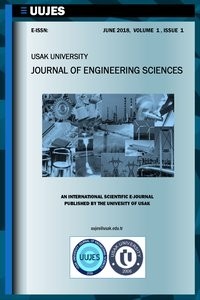Effects of Aluminium Dross and Iron Filings Particulates on the Mechanical Properties of Hybrid Thermoplastic (Nylon) Matrix Composites
Effects of Aluminium Dross and Iron Filings Particulates on the Mechanical Properties of Hybrid Thermoplastic (Nylon) Matrix Composites
Utilisation of waste as filler in the production of polymer matrix composites for properties enhancement and solving the menace of environmental pollution has been explored in this study. 5 – 25 wt. % of 300 g of ground aluminium dross and iron filings with an average particles size of 50 µm were used to reinforce thermoplastic (nylon) matrix by casting at room temperature (270 C). Microstructural, water absorption, tensile strength, modulus of elasticity, hardness and impact energy tests were carried out on the developed samples. The microstructure of the samples revealed a uniform distribution of the reinforcements within the thermoplastic matrix with different morphology of the phases in the composites. The results showed that the hybrid composite exhibited the lowest water absorption of 0.23 %. It also exhibited the highest tensile strength and Brinell hardness number (BHN) of 1.83 MPa and 12.84 BHN respectively at 15 wt. % filler addition. The strong adhesion/bonding between the reinforcing particulates and the thermoplastic (nylon) matrix contributed to the reduction in the water absorption and enhancement of the tensile strength and hardness of the composites. The decrease in the mechanical properties of the composites could be due to poor dispersion of the particulates in the matrix resulting to weak bonding/adhesion of particulates to the matrix. The results indicated that these composites have potential for engineering applications and their development will go a long way in reducing/mitigating environmental pollution.
Keywords:
Polymer composites thermoplastic (nylon) matrix, aluminium dross, iron filings, mechanical Properties,
___
- 1. Brostow W, Dutta M, and Rusek P. Modified epoxy coatings on mild steel: tribology and surface energy. European Polymer Journal, 2010;46(11): 2181-2189.
- 2. Tapkire G, Parihar S, Patil P, and Kumavat HR. Recycling plastic used in concrete paver. International Journal of Research in Engineering and Technology, 2014; 3(9): 33-35.
- 3. Jassim AK. Recycling of polyethylene waste to produce plastic cement. Elsevier, Procedia Manufacturing, 2017; 8:635-642.
- 4. Singla M, and Chawla V. Mechanical properties of epoxy resin-fly ash composite. Journal of Minerals & Materials Characterization & Engineering, 2010;9(3):199-210.
- 5. Hemanth R, Sekar M, and Suresha B. Effects of fibers and fillers on mechanical properties of thermoplastic composites. Indian Journal of Advances in Chemical Science, 2014;2:28-35.
- 6. Rahman RM, Rahman MM, Hamdan S, and Lai JCH. Impact of maleic anhydride, nanoclay and silica on jute fiber reinforced polyethylene biocomposites. Bio-Resources 2016; 11:5905-5917.
- 7. Chen RS, Ahmad S, Gan S. Characterization of rice husk incorporated recycled thermoplastic blend composites. Bio-Resources, 2016;11: 8470-8482.
- 8. Agunsoye JO, Talabi SI, Awe O, and Kelechi H. Mechanical properties and tribological behaviour of recycled polyethylene/cow bone particulate composite. Journal of Materials Science Research, 2013;2:41-50.
- 9. Islam MR, Beg MDH, Gupta A. Characterization of laccase-treated kenaf fibre reinforced recycled polypropylene composite. Bio-resources, 2013; 8:3753-3770.
- 10. Mat-Shayuti MS, Abdullah MZ, and Megat-Yusoff PSM.. Water absorption properties and morphology of polypropylene/polycarbonate/polypropylene-graft-maleic anhydride blends. Asian Journal of Scientific Research, 2013;6(2):167-176.
- 11. Khanam PN, and Al-Maadeed MA. Processing and characterization of polyethylene based composites. Advanced Manufacturing: Polymer & Composites Science, 2015;1(2): 63-79.
- 12. Tewari M, Singh VK, Gope PC, Chaudhary AK. Evaluation of mechanical properties of bagasse-glass fiber reinforced composite. Journal of Materials and Environmental Science, 2012; 3:171-184.
- 13. Pantyukhov P, Kolesnikova N, and Anatoly P. Preparation, structure, and properties of biocomposites based on low-density polyethylene and lignocellulosic fillers. Polymer Composites, 2016;37:1461–1472.
- 14. H'ng PS, Lee AN, Hang CM, Lee SH, Khalina A, and Paridah MT. Biological durability of injection moulded wood plastic composite boards. Journal of Applied Science, 2011;11:384-388.
- 15. Renner K, Yang MS, Móczó J, Choi HJ, and Pukánszky B. Analysis of the debonding process in polypropylene model composites. European Polymer Journal, 2005:41:2520–2529.
- 16. Durowaye SI, Sekunowo OI, Lawal GI, Shittu S, and Duru P. Effects of silicon carbide, millscale, and magnesia particulates on the mechanical properties of hybrid unsaturated polyester resin matrix composites. Usak University Journal of Engineering Sciences (UUJES), 2018;1(1):28-37.
- 17. Rutz BH. Improvement of mechanical properties of polymeric composites. Ph.D. Thesis, Department of Chemical Engineering, University of Washington, 2014; USA.
- 18. Mechtali FZ, Essabir H, Nekhlaoui S, Bensalah MO. Mechanical and thermal properties of polypropylene reinforced with almond shells particles: impact of chemical treatments. Journal of Bionic Engineering, 2015;12:483-494.
- 19. Rufai OI, Lawal GI, Bolasodun BO, Durowaye SI, Etoh JO. Effect of cow bone and groundnut shell reinforced in epoxy resin on the mechanical properties and microstructure of the composites. World Academy of Science, Engineering and Technology (WASET), International Journal of Chemical, Molecular, Nuclear, Materials and Metallurgical Engineering, 2015;9:353-359.
- 20. Durowaye S, Bolasodun B, Ayoola W, Olarinde A, Apena Q. Improvement of polyethylene matrix composites using coconut shell and cow bone particulates. Kufa Journal of Engineering, 2019;10(3):134-150.
- 21. Al-Mosaw AI, Al-Maamori MH, and Wetwet ZA. Mechanical properties of composite material reinforcing by natural-synthetic fibers. Academic Research International, 2012;3(3):108-112.
- Başlangıç: 2018
- Yayıncı: Uşak Üniversitesi
